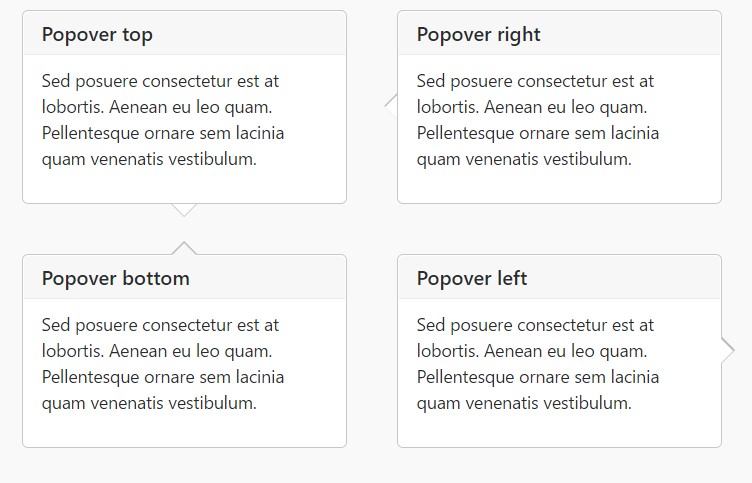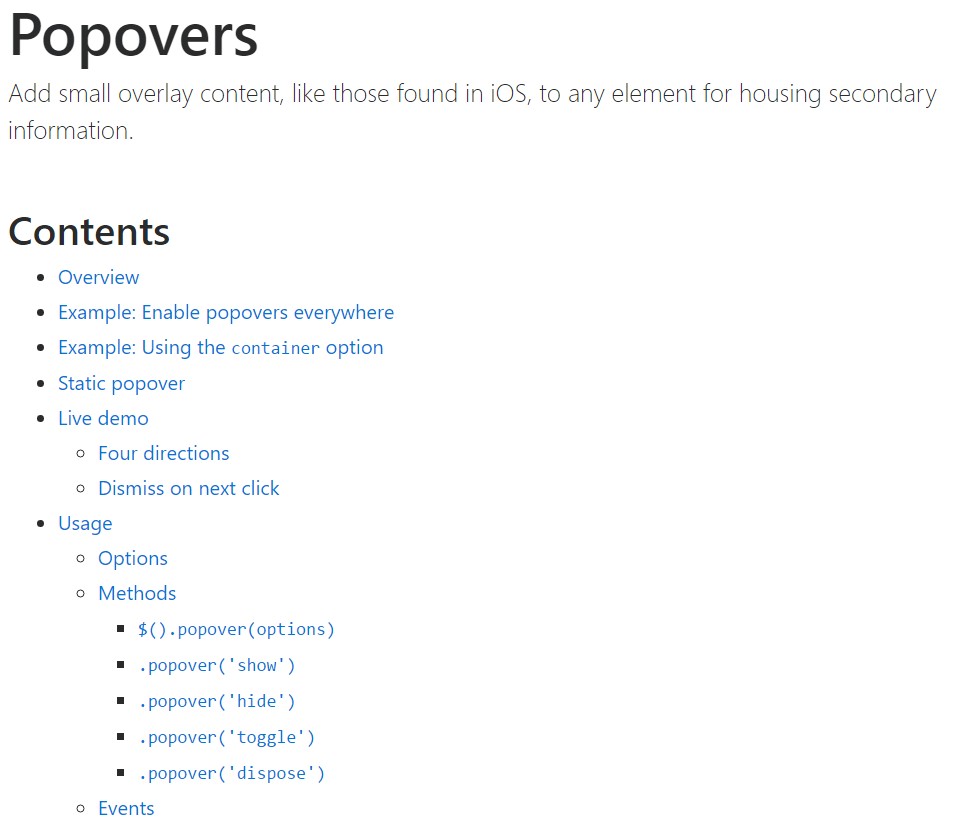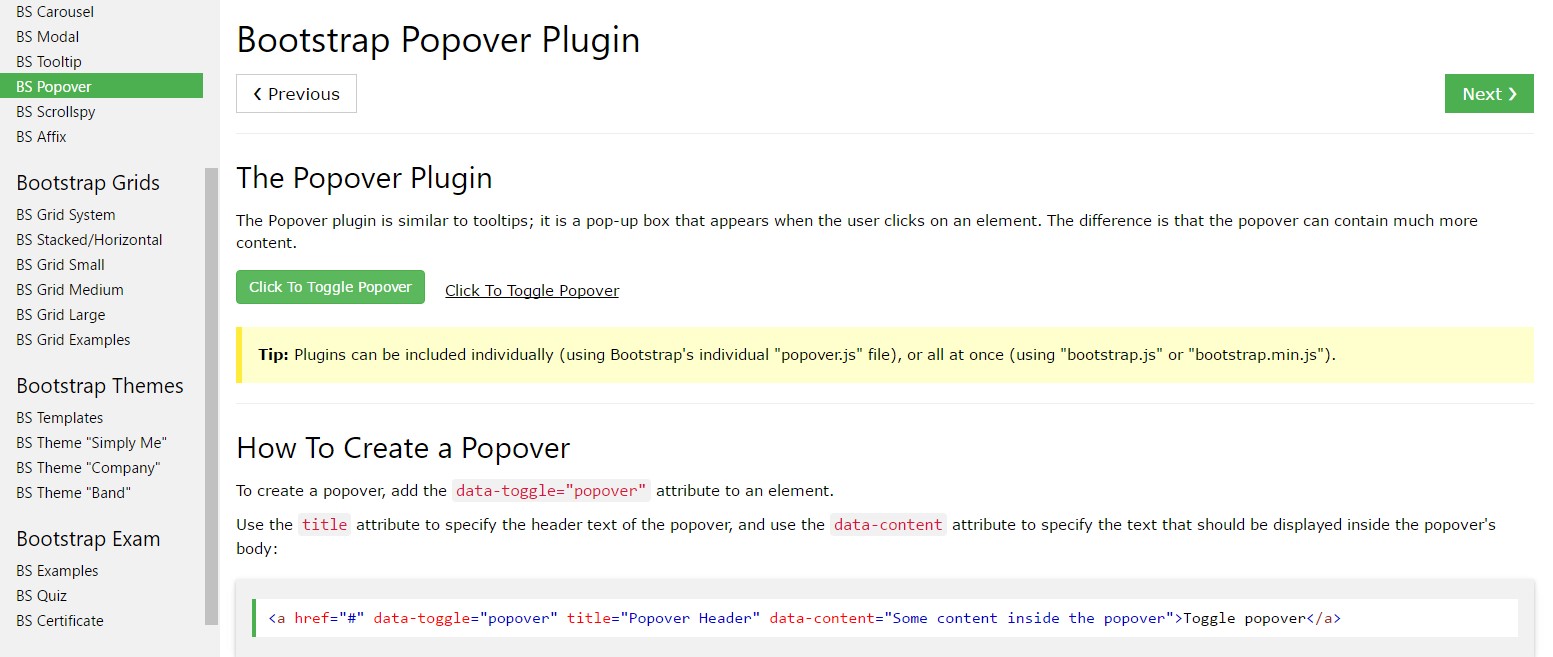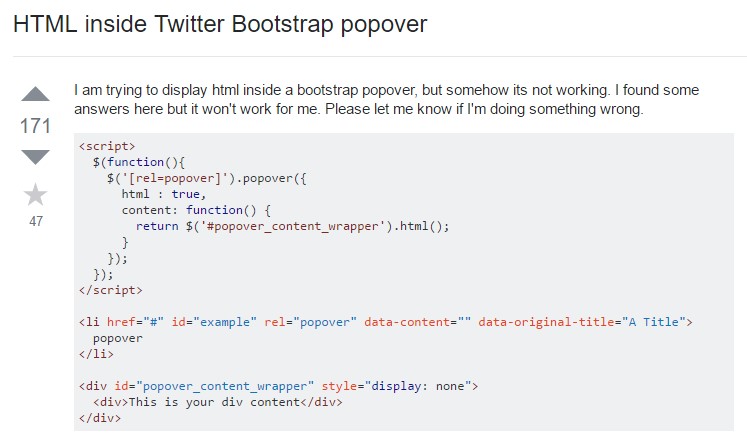Bootstrap Popover Position
Intro
The versions
Bootstrap is among the best practical and cost-free open-source programs to create internet sites. The most recent version of the Bootstrap operating system is named the Bootstrap 4. The platform is already in its alpha-testing phase but is easily accessible to internet developers throughout the world. You may also make and suggest improvements to the Bootstrap 4 previously its final version is introduced.
Usage of the Bootstrap 4
Along with Bootstrap 4 you will be able to get your internet site now faster than ever before. Also, it is reasonably extremely much simpler to use Bootstrap to develop your web site than other programs. By having the integration of HTML, CSS, and JS framework it is among the absolute most well-known platforms for web growth.
Certain elements and techniques in Bootstrap 4
A number of the greatest functions of the Bootstrap 4 incorporate:
• An improvised grid structure which allows the user to obtain mobile device friendly sites along with a fair level of comfort.
• A number of utility guidance sets have been featured in the Bootstrap 4 to promote easy studying for beginners in the field of web design.
Items to take note
Step 2: Rewrite your article by highlighting words and phrases.
, the bonds to the older version, Bootstrap 3 have not been completely cut off. The developers have made sure that the Bootstrap 3 does get regular updates and bug fixes along with improvements.
Contrasts comparing Bootstrap 4 and Bootstrap 3
• The assistance for many different web browsers as well as operating systems has been involved in the Bootstrap 4
• The overall size of the font is improved for convenient observing and web site construction experience
• The renaming of several components has been performed to ensure a much faster and even more dependable web-site development system
• Having brand new modifications, it is attainable to generate a extra active site along with very little efforts
Bootstrap Popover Position
And now let all of us go to the main material.
Assuming that you like to add in various supporting information on your website you can certainly employ popovers - simply provide little overlay content.
How to apply the popover plugin:
- Bootstrap Popover Button depend upon the Third party library Tether for placing. You will need to include tether.min.js just before bootstrap.js needed for popovers to operate!
- Popovers demand the tooltip plugin considering that a dependency .
- Popovers are opt-in for effectiveness causes, and so you must activate them by yourself.
- Zero-length title and content values will certainly never show a Bootstrap Popover Button.
- Indicate container:'body' in order to stay away from rendering issues around more complicated components ( such as Bootstrap input groups, button groups, etc).
- Producing popovers on hidden components will definitely never run.
- Popovers for . disabled or disabled components need to be triggered on a wrapper element. - Anytime triggered directly from links that span several lines, popovers will definitely be centered. Apply white-space: nowrap; on your <a>-s to keep away from this kind of activity.
Did you understood? Good, let us see precisely how they function using some scenarios.
You must include tether.min.js just before bootstrap.js in order for popovers to work!
Illustration: Implement popovers all over
One practice to initialize all popovers in a page would be to pick out all of them by their data-toggle attribute:
$(function ()
$('[data-toggle="popover"]').popover()
) Good example: Using the container opportunity
When you obtain some styles on a parent feature which conflict with a popover, you'll want to define a custom container That the popover's HTML shows up in that aspect instead.
$(function ()
$('.example-popover').popover(
container: 'body'
)
)Static popover
Four possibilities are accessible: top, right, bottom, and left straightened.

Live demo

<button type="button" class="btn btn-lg btn-danger" data-toggle="popover" title="Popover title" data-content="And here's some amazing content. It's very engaging. Right?">Click to toggle popover</button>Four ways

<button type="button" class="btn btn-secondary" data-container="body" data-toggle="popover" data-placement="top" data-content="Vivamus sagittis lacus vel augue laoreet rutrum faucibus.">
Popover on top
</button>
<button type="button" class="btn btn-secondary" data-container="body" data-toggle="popover" data-placement="right" data-content="Vivamus sagittis lacus vel augue laoreet rutrum faucibus.">
Popover on right
</button>
<button type="button" class="btn btn-secondary" data-container="body" data-toggle="popover" data-placement="bottom" data-content="Vivamus
sagittis lacus vel augue laoreet rutrum faucibus.">
Popover on bottom
</button>
<button type="button" class="btn btn-secondary" data-container="body" data-toggle="popover" data-placement="left" data-content="Vivamus sagittis lacus vel augue laoreet rutrum faucibus.">
Popover on left
</button>Dismiss upon coming mouse click
Work with the focus trigger to dismiss popovers on the next hit that the user does.
Special markup needed for dismiss-on-next-click
For right cross-browser as well as cross-platform behaviour, you must operate the <a> tag, not the <button> tag, plus you in addition will need to provide a tabindex attribute.

<a tabindex="0" class="btn btn-lg btn-danger" role="button" data-toggle="popover" data-trigger="focus" title="Dismissible popover" data-content="And here's some amazing content. It's very engaging. Right?">Dismissible popover</a>$('.popover-dismiss').popover(
trigger: 'focus'
)Treatment
Empower popovers via JavaScript
$('#example').popover(options)Opportunities
Selections may possibly be successfully pass by using information attributes or JavaScript. For information attributes, append the option name to data-, as in data-animation="".


Details attributes for specific popovers
Options for particular popovers have the ability to additionally be indicated via the usage of data attributes, being described above.
Techniques
$().popover(options)
Initializes popovers for the component variety.
.popover('show')
Reveals an element's popover. Returns to the user just before the popover has actually been shown (i.e. before the shown.bs.popover event takes place). This is regarded as a "manual" triggering of the popover. Popovers whose both title and web content are zero-length are never presented.
$('#element').popover('show')
.popover('hide')
Disguises an element's popover. Come back to the caller just before the popover has really been disguised (i.e. just before the hidden.bs.popover event happens). This is thought of a "manual" triggering of the popover.
$('#element').popover('hide')
.popover('toggle')
Activate an element's popover. Returns to the user prior to the popover has in fact been shown or disguised (i.e. right before the shown.bs.popover or hidden.bs.popover event takes place). This is regarded a "manual" triggering of the popover.
$('#element').popover('toggle')
.popover('dispose')
Disguise and wipes out an element's popover. Popovers that work with delegation ( that are built using the selector option) can not actually be personally gotten rid of on descendant trigger elements.
$('#element').popover('dispose')
Events

$('#myPopover').on('hidden.bs.popover', function ()
// do something…
)
Look at a number of video guides relating to Bootstrap popovers
Linked topics:
Bootstrap popovers authoritative records

Bootstrap popovers guide

Bootstrap Popover question

$().popover(options)
Initializes popovers for the component variety.
.popover('show')
Reveals an element's popover. Returns to the user just before the popover has actually been shown (i.e. before the shown.bs.popover event takes place). This is regarded as a "manual" triggering of the popover. Popovers whose both title and web content are zero-length are never presented.
$('#element').popover('show').popover('hide')
Disguises an element's popover. Come back to the caller just before the popover has really been disguised (i.e. just before the hidden.bs.popover event happens). This is thought of a "manual" triggering of the popover.
$('#element').popover('hide').popover('toggle')
Activate an element's popover. Returns to the user prior to the popover has in fact been shown or disguised (i.e. right before the shown.bs.popover or hidden.bs.popover event takes place). This is regarded a "manual" triggering of the popover.
$('#element').popover('toggle').popover('dispose')
Disguise and wipes out an element's popover. Popovers that work with delegation ( that are built using the selector option) can not actually be personally gotten rid of on descendant trigger elements.
$('#element').popover('dispose')Events

$('#myPopover').on('hidden.bs.popover', function ()
// do something…
)Look at a number of video guides relating to Bootstrap popovers
Linked topics:
Bootstrap popovers authoritative records

Bootstrap popovers guide

Bootstrap Popover question
